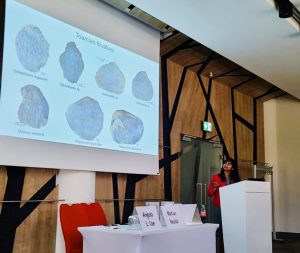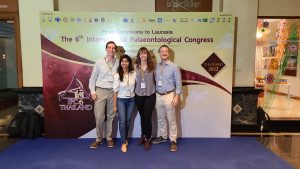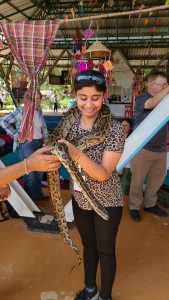August 31, 2023
In this article, Sinjini shares her experiences and thoughts about two quadrennial (happening every four years), international scientific meetings that she attended in 2022, namely the International Congress on Jurassic Systems and the International Paleontological Congress.
Scientific conferences are exciting occasions to be at and are certainly a crucial part of grad school life. Conferences give us the platform to share our research with our scientific communities, and beyond. Often the big conferences like the Geological Society of America (GSA), the American Geophysical Union (AGU) or the European Geosciences Union (EGU) annual meetings become the best places for creation and expansion of our scientific networks, exchange of research ideas and collaboration, and to meet old and make new friends. As much as it is important to attend large conferences, attending smaller conferences specific to our research topic (for example, the Gordon Research Conferences) or those that occur every two or four years are important too.
International Congress on Jurassic systems

The Jurassic conference brought together researchers working on the Jurassic period to Budapest (Hungary) in August 2022. It was a conference for scientists working on the Triassic/Jurassic boundary up to the Jurassic/Cretaceous boundary. The technical sessions were divided into 12 themes including sessions on Jurassic paleontology, sedimentology, stratigraphy, and tectonics. I presented my research in the session titled, “The Toarcian OAE A.K.A. Jenkyns event (IGCP 655)”. Being small (about 100 people), the coffee and lunch breaks were excellent times for getting valuable insights and feedback about my work. It was also easier to find the scientists I wanted to connect with. However, the sessions were so specific to my study, at times it became challenging to pick amongst concurrent sessions.
For the mid-conference field trip, all attendees were taken to the Geological Garden in the neighboring town of Tata, where we got a glimpse of the Tethyan Jurassic stratigraphy. We were provided a guided tour of the Garden, where we saw rock samples from the Triassic/Jurassic boundary, lots of Jurassic fossils including ammonite and bivalve beds, and a mineral and fossil collection. The geopark is one of Hungary’s most important geoheritage sites because of its geological and educational values.
Budapest is a very charming city! We thoroughly enjoyed the city vibes, brimming with delicious Hungarian food and lovely people. We now know Budapest as one single city; interestingly, prior to 1873 Buda and Pest were two different cities separated by the river Danube.
Finally, the Congress was wrapped up with a very fancy cruise dinner on the Danube River, where we got to capture some stunning views of the Hungarian Parliament. I really enjoyed attending the Jurassic conference because of all the super specific technical sessions pertinent to my dissertation topic and the scientists who presented their research in the sessions.

6th International Paleontological Congress (IPC)
IPC 6 was held in Khon Kaen, Thailand in November 2022. I noticed there were more Paleontologists from Asia and Europe than the USA. It was a larger conference as compared to the Jurassic conference with 35 scientific sessions. I presented my work in the “Life on the Shelf” (open) session. There were several sessions on cutting-edge Paleontological outreach and education. It was mind-blowing to see the innovative paleontological outreach ideas from creating story books to short films to museum exhibitions.

A very different event was the mid-conference trip to the King Cobra Village, famous for being home to the native Asian King Cobra snakes. Interested attendees were taken to the village, where we were informed about the history of the village before watching snake shows. Following the shows, we had the opportunity to hold the different snakes. Although I did hold a snake round my neck, I am not sure how I would react if I saw a king cobra in its natural environment! But thankfully, I did not encounter a king cobra during the park tour!

By attending and presenting at these small, international conferences, I gained a new sense of appreciation for scientific meetings. I got the opportunity to meet several scientists whose papers I have been citing for my own research articles. While unfortunately, the cost and carbon footprint of international travel is high, from a discussion angle, it was bliss to return to in-person conferences. Discussions and networking were so much easier when in the same physical space rather than across computer screens. Both the conferences, however, had the hybrid option, so researchers who were not able to travel could present their work through Zoom.
Although I have presented my research work on Jurassic Paleontology at GSA meetings before, the ease of navigating and presenting at the Jurassic conference allowed me to know more about research advances in the Jurassic period including Jurassic basins, sedimentation, tectonics and on Jurassic boundary events. Similarly, I noticed the International Paleontology Congress was attended more by Paleontologists working in Asia (likely because it was in Thailand) and Europe. Therefore, the IPC gave me the opportunity to network with scientists, whom I had not met in previous GSA meetings.
Some other advantages included, it was easier to switch session rooms, and to find the scientist I wanted to talk to; higher chances of meeting the scientists whose papers we have been reading and citing; and receiving feedback from the experts in real time. I had such a great time, I recommend you take the opportunity to attend a small, subject-specific conference if you can! It was well worth it.
It was such a rewarding and delightful experience to be part of the Jurassic and the Paleontological Congress’. I thank the conference organizers for convening such insightful sessions, my collaborators for the feedback on my research presentation, and of course the Jackson School’s professional development funds and my supervisor’s NSF Career award for the financial assistance.